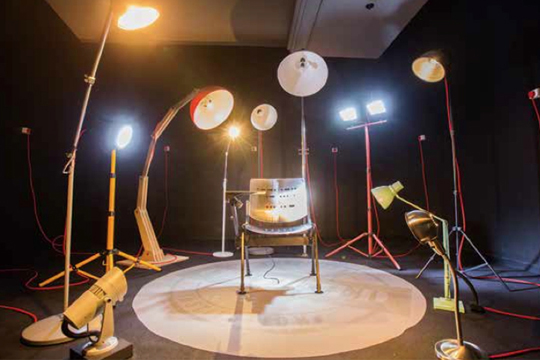THE PRESIDENT’S YOUNG TALENTS 2013
| June 5, 2013 | Post In LEAP 20

The President’s Young Talents (PYT), inaugurated in 2001 and organized by the Singapore Art Museum (SAM) and the Istana, aspires to “nurture a developmental platform for promising local artists under the age of 35 working with emerging contemporary art practices.” PYT began to adopt a new format in 2009, with members from the curatorial committee— who nominated and eventually selected these artists— to also mentor them as they make a newly commissioned work for the competition. This was a significant shift away from the open submission shows of Singapore’s past, the artists’ relationship with the jury suddenly a meaningful process of critical engagement.
Grace Tan’s Refuge extends from a practice that bridges mathematics, fashion design, and art by linking plastic loop pins together to create a surreal cloud-like sculptural form that shifts between the optical illusion of clouds as a natural phenomenon and its artifice using man-made materials, but yet remains distant from the viewer, almost cold. Boo Junfeng is a filmmaker. His work Mirror uses two video screens that meet at an inclined angle to create the illusion of two worlds happening simultaneously. He sets his film in the context of the Malayan Emergency (1948-60) at the Bukit Brown cemetery, alluding to a cyclical notion of history whereby a current Singapore soldier with a Malayan communist soldier are defending Singapore for different reasons and ideologies on a cemetery that embodies their memories— and is about to be redeveloped and erased in a country that forgets.
Using 16mm film to project ghostly images, Liao Jiekai’s Brothers’ Quarters investigates the “afterlife” of conserved buildings. This site-specific work, mounted in a part of SAM that was previously a school called the Saint Joseph’s Institute, falls short of initiating a conversation with the audience on the double-edged sword that is building conservation in Singapore. Ryf Zaini’s Unveil the Curtain to the Window with No Ledge, an interactive installation of lights whereby one may sit on a chair and bask in rhythmic flashes, uses technology to place the spotlight on the viewer, who is now being viewed and perhaps questioned about his or her understanding of contemporary art. Likewise, the installation’s intended meaning is lost on the very audience it seeks to engage with, appearing simply theatrical instead.
Robert Zhao Renhui’s The Quieting and the Alarming is an installation that tracks the process of trapping and hunting wild boars in Singapore, whose population, unchallenged by any native predators, has risen to the point of being ecologically damaging. His work questions how the authorities came to the decision to cull them based on advice by “experts” whose science might be established by facts that are actually half-truths. Revising Art: The Ten Year Series by Zaki Razak is the most ambitious and engaging work of all. This tent, displaying the work’s title in bold and thus recalling the Singaporean obsession with the “ten year series” compilation books of past examination papers, succeeds in bridging the gap between art and its audiences by questioning how art is taught and communicated through academies and institutions such as SAM. Razak’s interdisciplinary, collaborative, and informal way of engaging audiences through workshops and art talks is an artistic strategy to close the gap with reality that often characterizes the formal, distanced, and sometimes patronizing pedagogy of art institutions.
As an art competition, PYT recognizes the absurdity of comparing filmmakers to photographers or painters, yet it reveals current movements towards interdisciplinary practices in Singapore. Situated and judged in this expanded field, these practices reveal startling coincidences and connections that transcend form, subject, and medium. The mentoring aspect of PYT could have been more curatorially visible to reveal the critical engagements, disagreements, and meeting of minds in the making of the artworks—which is ultimately what sets this competition apart from others, offering a greater reward than any monetary prize could.

